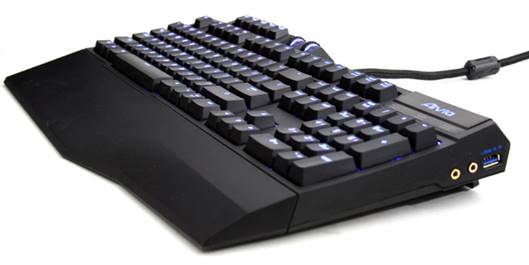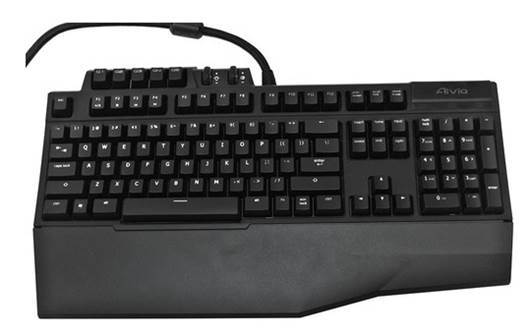Like a 21st century Dell
keyboard. In a good way
While the likes of the Mad Catz STIKE 7
keyboard are a bit of a guilty pleasure for this here reviewer, I am infinitely
more pleased by simpler, more effective keyboard design. In fact, were it not
for the fact I constantly mis-typed my passwords, I would still be using the
plain black Das keyboard. Yes, the one with no key markings at all. So when
Gigabyte’s latest Aivia range landed on my desk I couldn’t help but go a little
gooney. And when it lit up blue, I was all over the Osmium like a nun in heat.

Gigabyte
Aivia Osmium
The Osmium is utterly retro, but with
enough modern extras to make it relevant in today’s crowded gaming peripherals
market. Take away the sturdy wrist rest and the individual LED backlighting,
and you’re be forgiven for thinking you were looking at a Dell keyboard from
the early 90s. I think we’ve still got a few dotted around PCF Towers.
For a long while, people round here actually sought out the PS/2 mechanical
versions for FPS gaming, such were their accuracy and response.
Expletive deleted
Let’s get the gaming specific stuff out of
the way first. The Osmium comes with onboard memory for five full gamer
profiles, holding up to 70 different macros for the busy player. Flicking
between the profiles is a matter of pressing the large rocker switch with the
breathing Aivia logo on it. The five colours indicate the different profiles,
and you can access the macro and shortcut functionality via the GHOST macro
engine software. You’ll have to head to the gigabyte website to dig out the
utility, but it’s less than a 12MB download so shouldn’t tax your ISP
restrictions too much. As mentioned, you don’t have to use the extra five ‘G’
keys as macros; you can mix and match between macro and shortcut as you see
fit.

The
Gigabyte Aivia Osmium is pictured without the wrist rest.
For me, though, it’s all about how good the
Osmium is in general PC use. I’m typing this review on the board right now and
it’s seriously making me consider tagging this in and replacing the Corsair K60
I’ve been typing on for the last six months. The non-slip coating one ach key
means you won’t slip and the 2mm actuation point one ach key means you can be
quite delicate with your keypresses and still retain your accuracy. I’m also
really impressed with the LED backlighting, easily accessed by a wheel switch
at the top of the board next to the ‘G’ macro keys. Press the wheel down to
toggle the lights on or off, and move it up or down to tune the intensity of
the lighting on the fly. I find the top setting a little too bright in normal
light in the dark it would melt your face off like that Nazi officer in Raiders
of the Lost Ark. Next to that is another, similarly useful wheel switch to
look after the volume. Having both of these features accessible by a seemingly
analogue wheel is very satisfying.

These
two wheels are located directly to the right of the macro keys.
My only real issue is the fact that gaming
keyboards now have to cost at least $150 before they can be taken seriously.
But considering the K60 is still around $120, the awesome Mionix Zibal 60 is
knocking around at $150 and the Mad Catz STIKE 7 will cost you your firstborn
male child, the Osmium’s price isn’t that bad.
|
Vital
Statistics
·
Price: $149
·
Manufacturer: Gigabyte
·
Web: http://uk.gigabyte.com
·
Layout: Europe 105-key
·
Switches: Cherry Red Mechanical
·
Interface: USB 2.0
·
Macro keys: five programmable
·
Extras: USB 3.0 extension port
Verdict
·
Features: 9/10
·
Performance: 10/10
·
Value: 7/10
|